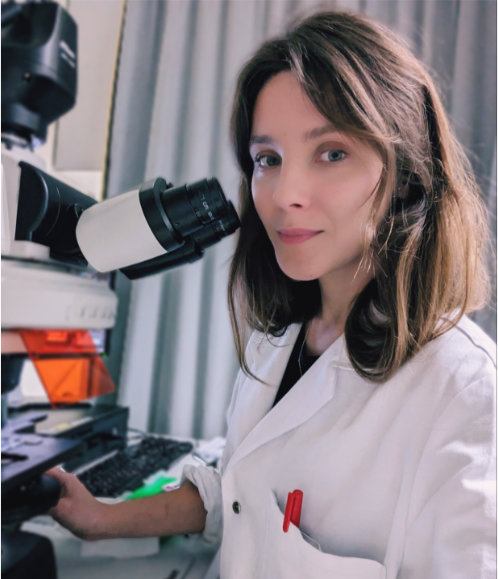Natalia Jakus

EPFL ENAC IIE EML
CE 1 544 (Centre Est)
Station 6
1015 Lausanne
Web site: Web site: https://eml.epfl.ch/
Research
I am a geomicrobiologist with an interest in microbially-driven redox changes of minerals and microbial survival strategies in the deep subsurface. My PhD work focused on groundwater microbial communities capable of removal of an agro-pollutant (nitrate) and oxidation of iron phases under anoxic conditions. Currently, I am applying my knowledge to predict the extent of microbial activity in future geological nuclear waste repositories (DGRs) to ensure the long-term stability of their safety functions.Projects
I am involved in the following international collaborations, experiments and research projects:- The Kiruna Natural Analogue (KiNa) - Natural analogue study in Kiruna mine in Sweden. Investigates the formations of smectite-rich clay occurring adjacent to magnetite deposits to explore the long-term evolution of bentonite components of a geological disposal system for radioactive waste.
- High Temperature Effects on Bentonite Buffers (HotBENT) - Generic-DGR-full scale long-term experiment based in Grimsel Test Site. Aims to evaluate current accepted safety functions by investigating the effects of high temperatures on bentonite-based barriers and their safety functions.
- IC-A: Iron Corrosion - In-situ field study based in Mont Terri Rock Lab. Aims to investigate corrosion of waste canisters in bentonite buffers.
- CONtainer CORrosion under Disposal conditions (ConCorD/EURAD) - Lab-based experiments run within EURAD initiative. Their goal is to optimise and evaluate the behaviour of materials for disposal containers in view of their long-term barrier performance.
- Innovative and new Container/canister materials under disposal field conditions: Manufacturing feasibility and improved Durability (InCoManD/EURAD-2) - Lab-based experiments run within EURAD-2 initiative. Their goal is to test the microbial impact on novel canister candidate materials (e.g., ceramics, composites, materials with protecting coatings) that are potentially less prone to corrosion than currently tested materials.
Publications
Selected publications
| Bayer, T., Jakus, N., Kappler, A., Byrne, J. M. Geo-Bio Interfaces (2024) |
Magnetite Nanoparticles are Metastable Biogeobatteries in Consecutive Redox Cycles Driven by Microbial Fe Oxidation and Reduction |
| Huang, J., Mellage, A., Pavon-Garcia, J., Gloeckler, D., Mahler, S., Elsner, M., Jakus, N., Mansor, M., Jiang, H., Kappler, A. Applied and Environmental Microbiology (2023) |
Metabolic performance and fate of electrons during nitrate-reducing Fe(II) oxidation by the autotrophic enrichment culture KS grown at different initial Fe:N ratios. |
| Huang, Y.M., Jakus, N., Straub, D., Konstantinidis, K.T., Blackwell, N., Kappler, A., Kleindienst, S. Systematic and Applied Microbiology (2022) |
'Candidatus Ferrigenium straubiae' sp. nov., 'Candidatus bremense' sp. nov., 'Candidatus Ferrigenium altingense' sp. nov., are autotrophic Fe(II)-oxidizing bacteria of the familiy Gallionellaceae. |
| Osenbrück K., Blendinger E., Leven C., Rügner H., Finkel M., Jakus N., Schulz H., Grathwohl P. Hydrogeology Journal (2022) |
Nitrate reduction potential of a fractured Middle Triassic carbonate aquifer in Southwest Germany |
| Jakus, N., Blackwell, N., Osenbrueck, K., Straub, D., Byrne, J.M., Wang, Z., Gloeckler, D., Elsner, M., Lueders, T., Grathwohl, P., Kleindienst, S., Kappler, A. Applied and Environmental Microbiology (2021) |
Nitrate removal by a novel autotrophic nitrate-reducing iron(II)-oxidizing culture enriched from a pyrite-rich limestone aquifer. |
| Jakus, N., Mellage, A., Hoeschen, C., Maisch, M., Byrne, J.M., Mueller, C.W., Grathwohl, P., Kappler, A. Environmental Science and Technology (2021) |
Anaerobic neutrophilic pyrite oxidation by a chemolithoautotrophic nitrate-reducing iron(II)-oxidizing culture enriched from a fractured-aquifer. |
| Jakus, N., Blackwell, N., Straub, D., Kappler, A., Kleindienst, S. FEMS Microbiology Ecology (2021) |
Presence of Fe(II) and nitrate shapes aquifer-originating communities leading to an autotrophic enrichment dominated by a Fe(II)-oxidizing Gallionellaceae sp.. |
| Schad, M., Halama, M., Jakus N., Robbins, L.J., Warchola, T.J., Tejada, J., Kirchhof, R., Lalonde, S.V., Swanner, E.D., Planavsky, N.J., Thorwarth, H., Mansor, M., Konhauser, K.O., Kappler, A. Chemical Geology (2021) |
Phosphate Remobilization from Banded Iron Formations during metamorphic Mineral Transformations. |
Other publications
Technical Reports & Deliverables
- Jakus, N., Bernier-Latmani, R. (2025). Microbial growth inhibition by compacted bentonite after an 8.5-year of in-situ incubation. NAB 22-50
- Jakus, N., Kulkarni, P.V., Dreher C., Kappler, A., Diomidis N., Mischler S., Bernier-Latmani, R. (2024). Deliverable D15.10: Impact of bentonite-associated oxygen on microbial activity and viability. HORIZON 2020 project EURAD. EC Grant agreement no: 847593
- Morales-Hidalgo, M., Povedano-Priego, C., Martinez Moreno, M., Jroundi F., L. Merroun, M., Alonso, U., Fernández, A.M., García-Gutiérrez, M., Mingarro, M., Missana, T., Nieto, P., Valdivieso, P., Bartak, D. S., Riha, J., Cerná, K., Šachlová, Š., Kašpar, V., Dobrev, D., Večerník, P., Jakus, N., et al. (2024).Deliverable D15.09: Integration of the findings on the impact of irradiation, dry density and particle size on the microbial community. HORIZON 2020 project EURAD. EC Grant agreement no: 847593.
- Jakus, N., Frutschi, M., Bernier-Latmani, R., Stopelli, E., Kober, F. (2024). HotBENT - Microbiological Baseline Characterisation at Emplacement. Nagra Technical Report (Arbeitsbericht) NAB 23-29.
- Alexander, W. R., Andersson, U. B., Bernier-Latmani, R., Delbos, E. M., Elliott, W. C., Fujimura, T., Gilg, H. A., Goto, T., Jakus, N., et al. (2024). KINA (Kiruna Natural Analogue) project. SKB Final report. SKB TR-24-01. ID 2037849.



